"We are what we repeatedly do. Excellence, then, is not an act, but a habit." --Aristotle
Address any questions or comments regarding this newsletter to the individual authors listed after each article or to its editor, Rick Weinzierl, 217-333-6651, weinzier@illinois.edu. To receive e-mail notification of new postings of this newsletter, call or write the same number or address.
In This Issue:
Regional Observations (from Nathan Johanning, Mike Roegge, and Kyle Cecil)
Fruit Production and Pest Management (cover crops for fruit and vegetables; strawberry cultivar evaluation; apple disease update)
Vegetable Production and Pest Management (aphids on pumpkins; downy mildew of cucurbits)
Upcoming Programs
The 2014 Illinois Specialty Crops, Agritourism, and Organics Conference will be held
January 8-10, 2014.
Check the Illinois SARE calendar for a full list of programs and links for registration.
http://illinoissare.org/ and http://illinoissare.org/calendar.php
Also see the University of Illinois Extension Local Food Systems and Small Farms Team’s web site at:
http://web.extension.illinois.edu/smallfarm/ and their calendar of events at http://web.extension.illinois.edu/units/calendar.cfm?UnitID=629.
- Taking Your Farm to the Next Level: Equipment for Scaling Up Production, September 21, 2013, 2:00 – 4:30 p.m. PrairiErth Farm, 2047 County Road 2100 N., Atlanta, IL. Hans Bishop of PrairiErth Farm will showcase specialty crops equipment that he uses to reduce hand work, improve efficiency, and increase employee job satisfaction. For more information and to register, see https://webs.extension.uiuc.edu/registration/?RegistrationID=7794.
- Good Agricultural Practices for Safer Fresh Produce, October 1, 2013, 9:00 a.m. – 3:00 p.m. University of Illinois Extension, Morris, IL. For more information and to register, see http://web.extension.illinois.edu/units/event.cfm?UnitID=629&EventID=62820.
- 2014 Illinois Specialty Crop, Agritourism, and Organics Conference, January 8-10, 2014, Crowne Plaza Hotel and Conference Center, Springfield, IL. Lots more details to come, but it’s time to mark your calendars. The keynote speaker on January 9 will be Elliot Coleman, co-author of Four-Season Harvest: How to Harvest Fresh Organic Vegetables from Your Home Garden All Year Long, and author of other widely popular books on high tunnel production and organic production. In addition to concurrent tracks on fruits, vegetables, herbs, agritourism, and organics on January 9 and 10, pre-conference workshops on January 8 will feature (1) Pumpkin Production, Pest Management, and Marketing; (2) Season Extension and Year-Round Markets; (3) GAPS and Food Safety Guidelines for Growers who Sell at Farmers’ Markets; and (4) Optimizing Plasticulture and Drip Irrigation Practices (a.m.) and Growing Unique Fruits and Vegetables (p.m.). In addition, training and testing for the Private Applicator License (pesticides) will also be offered on January 8.
Regional Observations
In southern Illinois...
although we had the heat of summer a few days ago, things are slowly starting to feel more like fall. Apple harvest is well underway, with many of the main apple varieties either well into harvest or just starting. Also, pumpkin harvest is starting, and pumpkins are starting to show up at some farmers’ markets and road-side stands.
Overall, we are still dry, with some of the driest areas having not seen any rain over 0.1” since early July. This has hit some areas pretty hard, especially on fall crops, including pumpkins. Many of these crops were not acclimated to recent hot weather because of the abnormally cool conditions in July and August. This, along with dry soils, really set back some plants and will limit their overall yield.
Don’t forget now is a great time to think about planting cover crops. I have had a lot of interest by local growers in adding cover crops to their operation.
Nathan Johanning (618-939-3434; njohann@illinois.edu)
In western Illinois...
It’s official now ... 4 counties in Illinois are now categorized in a severe drought area (Adams, Hancock, Mercer, and Henderson). Since July 1, I’ve received 2.84 inches (some have received more, some less). The good news was that on September 8, parts of the area were the recipients of a beneficial rain. As usual, amounts varied tremendously, with reports of over 2 inches to just a trace. Those on the upper end of the moisture can turn off the irrigation for a few days, while others have not been able to adjust watering at all. Those without irrigation and on the lower end of the precipitation amounts are struggling to keep up, especially with the high temperatures the week of September 9
Red raspberry and primocane blackberries are still flowering and producing, and how well they’re producing depends upon supplemental watering. Red raspberries without supplemental water on lower organic matter soils are fading fast, and some canes have died back with unripe fruit attached. Blackberries are handling the dry weather much better. Early apple harvest (Gala) and pears began the first week of September. Honey Crisp is just starting to ripen. Fruit tree condition is much better this year than last, as is fruit load. Dry soils and heat (100 degrees on Sept. 9, which tied a record) are driving the use of irrigation on strawberry crops to improve fruit set for next year.
Earlier-planted pumpkins look great considering the stress they’ve encountered the past 6 weeks. In some patches there are more orange fruit than green. In fact, many of the early planted pumpkins have been orange for 3 weeks or more. Many of the vines have turned chlorotic, leaving the pumpkins exposed to sun burn. Even with irrigation it has been difficult to keep pumpkin vines turgid during the heat of the day. Scattered outbreaks of aphids have plagued many growers, and cucumber beetle numbers have been low all summer.
Late plantings of green beans and cucurbits are still being picked. Cabbage loopers are still active on cole crops. High tunnel growers have pulled some or all tomatoes and replaced with greens and other fall/winter crops. It seems like everyone has tomatoes, and some have lowered prices to almost give-away. Germination of greens has been fairly good considering the heat of the past few weeks and the fact that most greens don’t germinate well in high soil temperatures.
Spotted wing Drosophila is present in red raspberries and probably other small fruits at this time.
Mike Roegge (217-223-8380; roeggem@illinois.edu)
Also in western Illinois...
A significant portion of western Illinois received varied amounts of rainfall the weekend of September 6-8. The Galesburg area received nearly two inches, with significant wind and tree damage. It was, however, very spotty, with areas just miles away getting a mere 0.1 inch. At a recent Pumpkin Field Day hosted by Iowa State University and the University of Illinois, we witnessed first-hand the value of drip irrigation for fruit and vegetable crops. Typically, we might not see irrigation in pumpkins, however, given the last two growing seasons, it is more than evident why this practice might be considered a new standard. For the value of the crop you are growing, in terms of sales and inputs, removing water stress from the equation makes sense. Several of the established growers I work with have irrigation capabilities for almost every crop they grow, excluding onions and garlic.
Other happenings here include significant fruit fly infestations. My colleague, Chris Enroth, Horticulture Educator, has been trapping Spotted Wing Drosophila (Drosophila suzukii) as well as the “regular” fruit fly (Drosophila melanogaster) that has long been common in late summer, in grapes, raspberries and high tunnel tomatoes. The high tunnel site had 87 in one trap. If you suspect you have fruit fly issues regardless of the type, contact your local extension educator for sticky cards and set up a simple trap. In addition to instructions provided in earlier issues of this newsletter, see http://ipm.wsu.edu/small/pdf/SWD_Bulletin_Eastern_WA_v1_04.pdf for directions on building a trap.
Kyle Cecil (309-342-5108; cecil@illinois.edu)
Fruit Production and Pest Management
Cover Crops for Fruits and Vegetable Production
Cover crops are a great way to improve soil and help increase crop productivity. Cover crops are gaining popularity in many agronomic crop production systems, and I think they are also equally if not more important in horticultural crops. This is especially true in vegetable production, where we often use a great deal of tillage to remove weeds and prepare a good seed bed for planting. Over time, repeated tillage causes compaction, makes the soil more susceptible to erosion, and speeds the loss of organic matter. Through the use of cover crops we can improve soil structure, help to replenish organic matter, manage weeds, and in some cases provide nitrogen as well.
Consider how you can incorporate cover crops into your growing system. Here are two examples:
- Plant a fall cover crop now in areas that you are no longer harvesting. Either incorporate them (till) or no-till crops into them next year.
- In new areas that have not been in production, take a year prior to planting (especially good prior to perennial fruit plantings) to build up the soil with a rotation of cover crops.
Annual ryegrass, cereal rye, and crimson clover are some of the most popular cover crops for fall planting, and now is an ideal time to seed all of them. Oats and daikon radishes are also good cover crops, but remember they will winter kill so they need to be planted very soon for the most benefit.
Remember when evaluating the performance of these crops that it is not all about the above ground growth. We see many times greater benefit from the extensive root systems rather than just the above ground growth. Crops such as annual ryegrass, cereal rye, clovers, and daikon radishes are very good at producing a lot of root biomass that aerates the soil, reduces compaction from multiple trips through the field, and eventually breaks down and turns into organic matter to benefit the soil. Also, the presence of the cover drop in the winter helps protect the soil from erosion where bare soil would otherwise be very susceptible to erosion.
For more detailed information on cover crops, see the Midwest Cover Crop Council website at www.mccc.msu.edu. There is a great deal of information about a wide range of cover crops, including articles and research on individual cover crops. The “Cover Crop Selector” link located on the left side of the homepage allows you to select your county and get detailed information the best time to plant each cover crop specific to your area and what benefits these crops can provide.
Remember that our soils are an integral part of any field production, so maintaining a healthy soil is a key component to maximizing crop production.
Nathan Johanning (618-939-3434; njohann@illinois.edu)
2013 Strawberry Trial
A trial to compare matted row strawberry varieties was initiated May 11, 2012, with the planting of 8 different matted row strawberries at the land lab at John Wood Community College in Quincy, IL. Varieties included: Galletta, AC Wendy, Earliglow, Honeoye, Daroyal, Darselect, Donna, and Jewel. The objective was to compare standard early (Earliglow), mid (Honeoye) and late (Jewel) season varieties with newer varieties.
Standard tillage and fertility practices for matted row strawberry production were followed, and bare root dormant plants were set on May 11. Plants were spaced 18” apart in rows 4’ apart with a row length of 20’. There were 4 replications. During the course of the summer of 2012, standard practices were followed: flowers were removed, weed control was used (herbicides as well as hand weeding), and trickle irrigation was provided when necessary throughout the summer. At the end of November straw was spread.
Straw was removed on April 9, 2013, and a Captan/Topsin fungicide program was followed at regular intervals. A cooler-than-normal spring followed, and harvest did not begin until June 6. A 6-foot length of row was harvested, and yields were extrapolated to a per-acre basis.
Yields for early-season varieties were:
Variety |
Yield/acre (lbs) |
Galletta |
16,219 |
AC Wendy |
21,420 |
Earliglow |
16,074 |
Yields for mid-season varieties were:
Variety |
Yield/acre (lbs) |
Honeoye |
22,436 |
Daroyal |
19,341 |
Yields for late-season varieties were:
Variety |
Yield/acre (lbs) |
Darselect |
27,972 |
Donna |
17,635 |
Jewel |
24,932 |
The cool spring delayed straw removal as well as first harvest. The harvest season was somewhat short, with the first picking of the early-maturity berries on June 6, and the last picking of the late season varieties occurring on June 27. Six foot of row was harvested, and the plants were picked very clean, much cleaner than commercial operations would have allowed for in some instances (the last two pickings of the early maturity varieties required 80-100 berries to fill a quart box). Very little disease or insect pressure was noted. After the final picking, renovation included fertilizing and tilling to narrow the beds. Trickle irrigation was used as necessary throughout the summer.
More detailed information on results is available at: http://web.extension.illinois.edu/abhps/cat88_4076.html. Thanks to Nourse Farms for plant supplies and to John Wood Community College for the land.
Mike Roegge (217-223-8380; roeggem@illinois.edu)
A Report on Apple Diseases in Illinois
Apple scab, caused by the fungus Venturia inaequalis, is a very serious apple and crabapple disease in Illinois. The disease occurs on the leaves, petioles, blossoms, and fruit. The most striking symptoms occur on the leaves and fruit.
Infections usually develop first on the undersides of leaves. Once the leaf has unfolded, both sides may be infected. As the infection progresses, the lesions become circular and slightly velvety and olive green. Fruit infection appear a few weeks after bloom as nearly circular, velvety, dark olive green lesions with the cuticle ruptured at the margins. Older lesions become black, scabby, and fruit often cracks.
Apple scab can be managed by cultural practices, planting resistant varieties, and fungicide applications. Managing this disease in Illinois apple orchards recently has become a challenging task. Scab has occurred in more apple orchards in Illinois in 2013 than the past 13 years. The major reasons for higher incidence of apple scab in Illinois are: (1) development of resistance of the scab fungus to some fungicides (e.g., sterol inhibitors and strobilurins) and (2) missing fungicide applications early in the season in 2013 (due to continuous rainfalls). Also, spread of the pathogen from crabapples to commercial orchards is likely another reason for occurrence of apple scab in Illinois. Minimizing primary inoculum, proper pruning of trees, and timely application of effective fungicides from green tip until petal fall are essential for effective management of apple scab. For fungicide control of apple scab, refer to the Midwest Tree Fruit Spray Guide (http://www.extension.iastate.edu/publications/pm1282.pdf). Presentations and discussions on effective management of scab in apple orchards are scheduled for the winter schools.
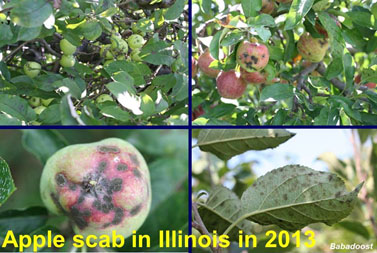
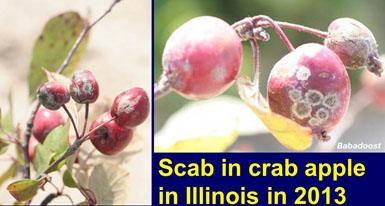
White rot, caused by the fungus Botryosphaeria dothidea, is a common disease in apple orchards in Illinois, causing up to 10% yield losses in some old Golden Delicious blocks. The pathogen infects fruit and twigs. Fruit lesions begin as small, often circular, slightly sunken tan spots, which may be surrounded by red halos. As lesions expand, the rotten area extends inward toward the core, forming a cylinder of rotten flesh. In more advanced stages, the core becomes rotten and the rotten area advances from the core region into the flesh until the entire fruit is rotten. Under warm conditions, rotten areas are usually soft, watery, and white to tan. Twig infections begin as discolored spots, which later develop into blisters that may exude a watery liquid.
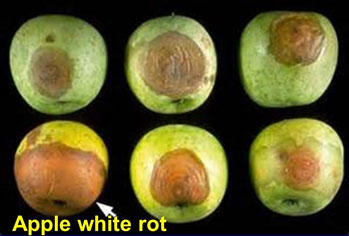
The fungus overwinters in dead bark, twigs, and cankers within the tree. Spores are produced throughout the growing season and are washed or blown onto fruit or twigs during rainy periods. Fruit infection can occur throughout the growing season, but rot symptoms usually do not appear before soluble solids near 10%. Pruning and removing all dead spurs, twigs, and branches from the orchard is essential for control of white rot. Removing current season fire-blighted twigs is also important because they can be colonized by the white rot pathogen. A fungicide spray program from bloom until harvest is important to assure white rot control. Effective fungicides for control of white rot of apples are listed on page 45 of the 2013 Midwest Tree Fruit Spray Guide: (http://www.extension.iastate.edu/publications/pm1282.pdf). Applications of Captan + Topsin-M, alternated with Sovran or Flint after petal fall (cover sprays) have been effective for control of white rot, black rot, and bitter rot in orchard trials in Illinois.
Fruit rot after bird damage. In some apple orchards in Illinois, a high incidence of bird damage on Honey Crip apples has been observed, resulting in crop losses of up to more than 10%. In most cases, bird damage is followed by fruit rot caused by opportunistic bacteria and fungi. Most of the affected fruit drop onto the ground and decay.
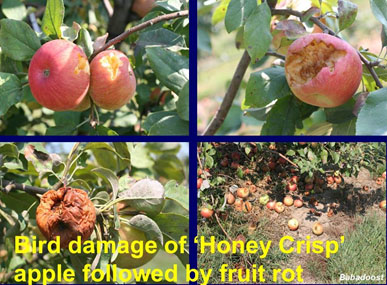
Necrotic leaf blotch of Golden Delicious apples. Every year, we experience a disorder on Golden Delicious apple trees known as “necrotic leaf blotch.” In 2013, severe necrotic leaf blotch has been observed in all apple orchards visited throughout Illinois. Necrotic leaf blotch of Golden Delicious apples appears not to be caused by a fungus, bacterium, air pollutant, or a nutrient deficiency. The causal agent of necrotic leaf blotch is unknown; therefore, the disease is often referred to as a physiological disorder. Its occurrence is related to air temperature, light intensity, and soil moisture. The disorder occurs worldwide on Golden Delicious. Prime Gold and Nugget are also affected.
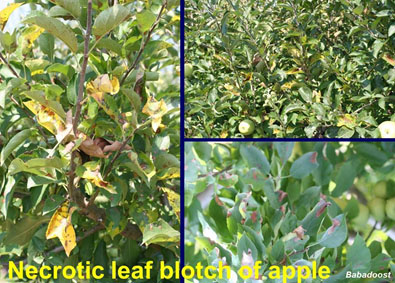
Necrotic leaf blotch is characterized by the development of necrotic blotches or irregular areas of dead tissue in mature leaves. Midshoot leaves are most often affected. Blotches are limited by the leaf veins and vary greatly in size. Affected leaves begin to turn yellow after about 4 days and abscise a few days later. Some green leaves with necrotic leaf blotch are also lost by abscission. Necrotic leaf blotch usually appears when a cool, rainy period is followed by hot summer weather. Some orchards or trees within an orchard may show little or no defoliation, while other orchards reach 50% defoliation. It has been reported that the disorder was less common where the fungicides ziram or thiram were used in the summer spray program. Foliar applications of zinc oxide also have been effective in reducing the severity of this disorder.
Mohammad Babadoost (217-333-1523; babadoos@illinois.edu)
Vegetable Production and Pest Management
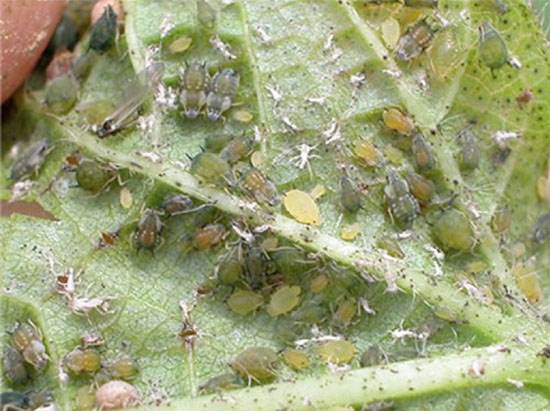
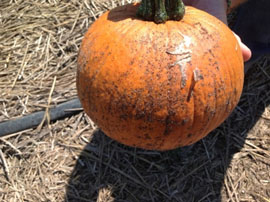
Aphids on pumpkins are common in many areas and may present problems with marketing infested or cosmetically damaged fruits. (I know, it’s amazing … customers buy pumpkins to carve grotesque holes in them but do not want to buy a pumpkin with stains from fungi that grow on aphid honeydew.) The aphids on pumpkins now are almost always the cotton-melon aphid. As vines die down, aphid colonies move to pumpkin fruits, often around the handle and “shoulders” and where the fruit rests on the soil. Their feeding may result in sunken areas on the fruit, and their presence, along with the honeydew they secrete, may reduce the crop’s marketability.
Aphid outbreaks often occur where a pyrethroid or Sevin XLR Plus has been used repeatedly through the season, killing lady beetles and other natural enemies that prey on aphids and limit their populations. In general, the insecticides used for Lepidopteran larvae, cucumber beetles, squash bugs, and squash vine borer are NOT effective against aphids. Where aphid control is necessary at the end of the season, Assail, Fulfill, or M-Pede (or another insecticidal soap) can be used effectively. M-Pede is labeled for use in organic production; very thorough coverage is required for it to be effective. Actara and Admire Pro are also effective aphicides, but they are especially toxic to bees, so if any late flowering is still ongoing or if there are flowering weeds in the field, they should not be used. See the 2013 Midwest Vegetable Production Guide for listings of products for aphid control on specific crops. For organic growers, neem, summer oils, and insecticidal soaps are moderately effective against aphids.
Rick Weinzierl (217-244-2126; weinzier@illinois.edu) and James Theuri (815-933-8337; jtheu50@illinois.edu)
Downy Mildew of Cucumber
On September 7, 2013, downy mildew was detected in a cucumber leaf sample sent from Arcola (Douglas County, east-central Illinois). This is the first report of downy mildew on cucurbits in Illinois in 2013. On September 8, I checked several cucumber, melon, pumpkin, watermelon, yellow squash, and zucchini patches in Champaign County, and no downy mildew was observed. The pathogen is likely to spread onto melon plants and may infect pumpkin and squash plants too. Downy mildew is not expected to impact yields in pumpkin, squash, and watermelon fields, as the season for these crops is coming to an end. Approximately 30% of processing pumpkin crops have been harvested, and harvest of jack-o-lantern pumpkins and winter squashes has already begun. Late-season cucumber fields should be sprayed at weekly intervals to prevent destruction of plants.
Downy mildew of cucurbits, caused by the oomycete Pseudoperonospora cubensis, is a very destructive disease of cucurbits. The pathogen that causes downy mildew of cucurbits does not overwinter in Illinois; instead it is blown into Illinois or brought in on plant material such as transplants. Downy mildew is favored by cool temperatures (59 to 68 F) and leaf wetness.
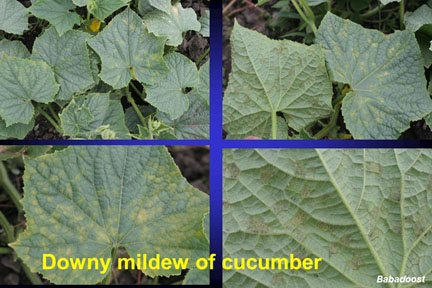
Downy mildew affects leaves only. The first symptom is usually the appearance of indistinct, pale green areas on the upper leaf surface. The pale green areas soon become yellow in color and angular to irregular in shape, bounded by the leaf veins. As the disease progress the lesions may remain yellow or become brown and necrotic. During moist weather the corresponding lower leaf surface is covered with a downy, pale gray to purple mildew. Often an upward leaf curling will occur. Several fungicides have been labeled for control of downy mildew of cucurbits, including products with the active ingredient phosphorus acid (Agri-Fos, Phostrol, ProPhyt), Curzate, Forum, Gavel, Presidio, Previcur Flex, Ranman, Revus, Tanos, and Zampro. In experimental plots in Illinois, spray application of Revus + Bravo Weather Stik (BWS), alternated with Ranman + BWS, Tanos + BWS, Gavel + BWS, or Zampro + BWS have been effective for control of downy mildew.
Mohammad Babadoost (217-333-1523; babadoos@illinois.edu)
University of Illinois Extension Specialists in Fruit and Vegetable Production & Pest Management
Extension Educators – Local Food Systems and Small Farms |
||
Bronwyn Aly, Gallatin, Hamilton, Hardin, Pope, Saline, and White counties |
618-382-2662 |
|
Katie Bell, Franklin, Jackson, Perry, Randolph, & Williamson counties |
618-687-1727 |
|
Sarah Farley, Lake & McHenry counties |
847-223-8627 |
|
Nick Frillman, Woodford, Livingston, & McLean counties |
309-663-8306 |
|
Laurie George, Bond, Clinton, Jefferson, Marion, & Washington counties |
618-548-1446 |
|
Zachary Grant, Cook County | 708-679-6889 | |
Doug Gucker, DeWitt, Macon, and Piatt counties |
217-877-6042 |
|
Erin Harper, Champaign, Ford, Iroquois, and Vermillion counties |
217-333-7672 |
|
Grace Margherio, Jackie Joyner-Kersee Center, St. Clair County |
217-244-3547 |
|
Grant McCarty, Jo Daviess, Stephenson, and Winnebago counties |
815-235-4125 |
|
Katie Parker, Adams, Brown, Hancock, Pike and Schuyler counties |
217-223-8380 |
|
Kathryn Pereira, Cook County |
773-233-2900 |
|
James Theuri, Grundy, Kankakee, and Will counties |
815-933-8337 |
|
Extension Educators – Horticulture |
||
Chris Enroth, Henderson, Knox, McDonough, and Warren counties |
309-837-3939 |
|
Richard Hentschel, DuPage, Kane, and Kendall counties |
630-584-6166 |
|
Andrew Holsinger, Christian, Jersey, Macoupin, & Montgomery counties |
217-532-3941 |
|
Extension Educators - Commercial Agriculture |
||
Elizabeth Wahle, Fruit & Vegetable Production |
618-344-4230 |
|
Nathan Johanning, Madison, Monroe & St. Clair counties |
618-939-3434 |
|
Campus-based Extension Specialists |
||
Kacie Athey, Entomology |
217-244-9916 |
|
Mohammad Babadoost, Plant Pathology |
217-333-1523 |
|